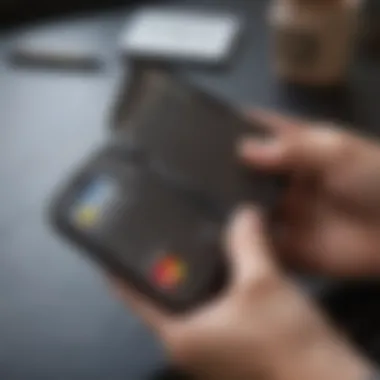Exploring the GPay Wallet: Features and Future Insights


Intro
In a world that spins faster by the minute, managing finances has taken on a whole new dimension thanks to digital wallets. One name that's been thrown around quite a bit is GPay, but what exactly does it bring to the table? As we venture into the intricacies of the GPay wallet, it’s crucial to establish a foundational understanding, especially for those who are either stepping into digital finance or are seasoned investors seeking to optimize their strategies.
GPay isn’t just another app on your phone; it’s a player in the larger game of digital payments. This article seeks to dissect its functionalities, security measures, and how it fits into the wider financial ecosystem. We aim to shed light on consumer behavior trends and how technological advancements are influencing ways we handle money today.
By the end, hopefully, you’ll have a comprehensive grasp of what GPay offers, as well as an eye toward future developments in the landscape of digital transactions.
Prologue to GPay Wallet
The digital payment landscape is transforming at breakneck speed, reshaping how people conduct transactions daily. At the forefront of this revolution is GPay Wallet, which stands out not just as a method of payment but as a sophisticated ecosystem that merges technology with financial management. The importance of exploring GPay Wallet stems from its far-reaching implications on personal finance, security, and convenience. For any financial enthusiast or individual investor, understanding GPay's capabilities is crucial in navigating the modern digital economy.
Overview of Digital Wallet Technology
Digital wallets represent a shift in payment methods, moving away from traditional cash and card payments to a more seamless, tech-oriented approach. In essence, these wallets store payment information securely, allowing users to transact effortlessly, often with just a swipe or tap on their mobile devices.
How does this work? Well, most digital wallets, including GPay, employ various technologies such as near-field communication (NFC), allowing two devices to communicate wirelessly. This not only simplifies payments but also enhances the security surrounding financial transactions.
Moreover, digital wallets offer a unique integration with mobile banking services. Users can link their bank accounts or credit cards directly for quick access, making monitoring and managing finances straightforward. With a few taps, one can send money to friends, pay bills, or shop online. Each of these functions highlights the value digital wallets bring—convenience, speed, and a more intuitive financial experience.
Historical Context of GPay's Development
GPay, originally known as Android Pay, stepped onto the scene in 2015. Its inception was a direct response to the growing demand for a digital payment solution that could cater to an increasingly mobile-driven world. Back then, the digital wallet market was still budding, comprising mainly standalone services that struggled with user adoption.
As technology advanced and consumer preferences shifted, GPay was rebranded in 2018 to unify Google's payment services under one umbrella. This move not only simplified the user experience but also made the payments more secure and intelligent by integrating features like machine learning for fraud detection and enhanced transaction security.
By forming partnerships with various retailers and financial institutions, GPay has continuously evolved, addressing user needs and preferences effectively. This historical context not only provides insight into how GPay has positioned itself in the market, but it also underscores its adaptability in the face of ever-changing technological and consumer landscapes.
"As digital wallets like GPay evolve, they redefine our expectations for convenience in financial transactions."
In summary, understanding the roots and evolution of GPay Wallet offers invaluable insight into its role as a reliable digital payment solution. With this foundation, we can now delve deeper into the various features that make GPay a significant player in modern finance.
Key Features of GPay Wallet
The significance of exploring the key features of GPay Wallet lies in understanding how these attributes differentiate it from competing products in the digital payment sector. GPay’s range of functionalities caters to the diverse needs of users, enabling smooth transactions, enhanced convenience, and integrating robust security measures. As consumers increasingly turn to digital solutions for financial transactions, highlighting the pivotal elements of GPay Wallet offers essential insights into its market positioning and overall user experience.
User Interface and Experience
A smooth user interface can make or break a digital wallet. GPay’s design strikes a good balance between functionality and aesthetics. The app is user-friendly, boasting a clean and intuitive layout. Navigating through its features feels effortless, which is crucial for anyone trying to find their way in the digital world.
For instance, the dashboard displays all vital information at a glance - from transactions history to remaining balance. Users particularly appreciate the immediate feedback provided during transactions, which boosts user confidence. Such an engaging user experience is likely to increase adoption and enhance customer satisfaction.
Payment Methods Supported
GPay Wallet’s versatility shines through its payment methods. Users can perform a variety of transactions tailored to different preferences. Here’s a deeper look at some of the notable payment methods supported by GPay:
Credit and Debit Cards
Credit and debit cards represent one of the most common methods for digital transactions. With GPay, linking a card is straightforward, allowing users to make payments with just a few clicks. This method’s primary appeal lies in its expediency. A key characteristic is the broad acceptance of cards globally, making it a universally beneficial option. Users can enjoy the unique feature of transactions being completed almost instantly, which is particularly advantageous during urgent payments. However, it is essential to consider some downsides, such as the potential for over-spending when using credit cards, which might deter some financially cautious individuals.
Bank Transfers
Bank transfers offer another layer of flexibility. Users appreciate this option for significant transactions, as it usually involves lower fees compared to other methods. A notable feature of GPay’s bank transfer ability is its integration with various banking institutions, facilitating seamless transfers between users and banks. This method is beneficial for payments that require higher dollar amounts. Nevertheless, bank transfers may not always be instantaneous, posing a drawback for those needing immediate access to funds.
Mobile Payments
Mobile payments are on the rise, and it’s no surprise that this capability is built into GPay Wallet. The appeal lies in their convenience; allowing users to complete payments on the go via their smartphones makes transactions quick and efficient. One standout feature of mobile payments through GPay is the integration with NFC technology, allowing contactless payments—an increasingly popular choice among consumers in retail settings. On the downside, reliance on mobile devices could be a potential limitation for those who prefer traditional payment methods or are not as tech-savvy.
Loyalty Programs and Rewards


No discussion on GPay’s features would be complete without mentioning the loyalty programs and rewards it offers. This aspect significantly enhances the overall value of the wallet. Users can accumulate points or cash back on purchases, which can be redeemed for various rewards. Such incentives not only encourage users to engage more with the app but also foster a sense of commitment and satisfaction. GPay's ability to provide users with tangible benefits helps in building lasting customer relationships.
Security Protocols Within GPay
Ensuring the safety of users' personal and financial information is of paramount importance, particularly in the realm of digital wallets. GPay employs a multifaceted approach to security, integrating various technological protocols designed to safeguard sensitive data from potential threats. By understanding these protocols, users not only feel more secure but also gain confidence in the evolving landscape of digital payment solutions.
Data Encryption Techniques
Data encryption is a cornerstone of GPay's security architecture. At its core, encryption transforms readable data into an incomprehensible format, making it unusable by unauthorized parties. GPay utilizes advanced encryption standards, ensuring that any transaction or storage of data is securely encoded.
- End-to-End Encryption: This technique ensures that data remains encrypted during its journey from sender to receiver. For GPay, this means that payment information is inaccessible during transmission.
- AES-256 Encryption: GPay employs the Advanced Encryption Standard with a 256-bit key length, recognized for its robust security features. This level of encryption is commonly used in military applications and by financial institutions, providing assurance of its reliability.
By implementing these techniques, GPay protects user data fiercely. If a data breach were to occur, encrypted data would be rendered virtually useless without the correct keys.
Two-Factor Authentication
Two-Factor Authentication (2FA) introduces an additional layer of security beyond the typical username-password combination. This method demands that users provide a second form of verification, significantly mitigatinng the risk of unauthorized access.
- SMS or Authentication Apps: When users log in or initiate significant actions, GPay sends a one-time code via SMS or utilizes an authentication app like Google Authenticator. Users must enter this code to complete the action, thereby thwarting potential intruders.
- Biometrics: GPay also offers biometric identification, such as fingerprint or facial recognition. These methods ensure that only the legitimate owner of the account can complete transactions, further tightening security.
The efficacy of 2FA is demonstrated by the substantial reduction in unauthorized access attempts, highlighting the importance of robust user verification in today's digital landscape.
Fraud Detection Mechanisms
GPay understands the potential risks that fraud presents in digital transactions. Therefore, it has put robust fraud detection mechanisms in place to flag and prevent suspicious activities before they escalate.
- Real-Time Monitoring: GPay employs algorithms that continuously monitor transactions, using machine learning to detect unusual patterns or behaviors. For instance, if a transaction deviates from the user's typical spending habits, it may trigger a red flag for further verification.
- User Alerts: Should any suspicious activity be detected, GPay promptly alerts the user via notifications. This ensures that users remain informed and can take immediate action, should they notice any discrepancies.
- Account Lockdowns: In case of suspected fraud, GPay can initiate an automatic lockdown of the account to prevent any further transactions until the user verifies their identity.
"The integration of sophisticated fraud detection systems transforms GPay into a fortress for financial transactions, offering peace of mind for users navigating the complex waters of digital payments."
In summary, GPay's commitment to security is reflected in its multilayered approach, intertwining data encryption, two-factor authentication, and proactive fraud detection mechanisms. Understanding these protocols can empower users, enhancing their confidence in utilizing the wallet for both everyday purchases and significant financial transactions.
Integration with Other Financial Services
In the rapidly evolving landscape of digital transactions, the integration of payment platforms with various financial services has become a pivotal aspect. For GPay Wallet, this means establishing connections with banks, retailers, and e-commerce platforms to enhance user convenience, broaden functionality, and provide a seamless financial experience. The symbiotic relationship between GPay and these entities underscores its role as not just a payment method but a comprehensive financial tool.
Connectivity with Banking Institutions
A strong connection with banking institutions allows GPay Wallet users to manage their finances more effectively. Through direct partnerships, GPay can facilitate instant bank transfers and simplify account management, which reflects a growing trend where mobile wallets are moving beyond mere transactional tools into full-service financial ecosystems.
Key Benefits of this Connectivity Include:
- Instant Transfers: Users can send and receive money in real-time, making financial transactions remarkably efficient.
- Account Linking: Users can link multiple bank accounts directly to their GPay Wallet, providing greater flexibility for managing expenses and payments.
- Enhanced Security: The support from banks generally means higher security standards, giving users peace of mind that their money is well-protected.
Partnerships with Retailers
GPay's success also hinges on its collaborations with retailers. This aspect not only maximizes payment acceptance but also enhances customer experience at the point of sale. Retailers partnering with GPay can offer exclusive deals and loyalty rewards, driving customer engagement and satisfaction.
Important Considerations Include:
- Widespread Acceptance: A growing network of retailers increases the usability of GPay, giving it a competitive edge over other wallets.
- Promotions and Deals: Retailers can run special promotions through GPay, enticing customers to use the wallet and simultaneously boosting sales.
- Streamlined Checkout Processes: With GPay, customers can skip long lines and tedious payment processes, allowing retailers to serve more customers efficiently.
E-commerce Integration
In today's digital-first economy, integrating GPay with e-commerce platforms is a game-changer. This allows users to complete online purchases swiftly, which is crucial as online shopping continues to grow.
Advantages of E-commerce Integration:
- Faster Transactions: GPay provides a simple, one-click payment option which minimizes cart abandonment during the checkout process.
- Increased Sales for Online Retailers: By offering GPay as a payment option, retailers can attract customers who prefer the security and convenience of digital wallets.
- Data Insights: Integration helps e-commerce businesses gain insights into consumer behavior, allowing for more targeted marketing campaigns.


"The integration of GPay with financial services paves the way for a more connected and cohesive financial experience for users."
Ultimately, the integration of GPay Wallet with various financial services is essential for developing a sophisticated and user-friendly digital payment ecosystem. By fostering connections with banks, retailers, and e-commerce, GPay is not only enhancing its functionality but also enriching the overall financial landscape.
User Adoption and Trends
Understanding the landscape of user adoption and trends surrounding GPay Wallet can illuminate key insights into how the payment system is perceived and utilized among different demographics. This aspect not only sheds light on the preferences of consumers but also indicates the shifting paradigms in digital finance. Notably, user adoption trends reflect the wider acceptance of cashless payments and the increasing comfort level of users engaging with technology. In this part, we will dissect demographic details, global adoption metrics, and how GPay stacks up against competitors in the digital payment arena.
Demographics of GPay Users
When it comes to GPay Wallet, the user demographics are as diverse as one might expect from a global product. The user base spans various age groups, economic classes, and tech-savviness. However, there’s a noticeable tilt toward younger audiences—Millennials and Generation Z—who seem to be more inclined to adopt mobile payment solutions. Reports suggest that around 70% of GPay users belong to the age bracket of 18-34, which speaks volumes about the inclination of younger individuals to lean towards tech-driven solutions.
Additionally, urban dwellers tend to dominate the user statistics, with many seeing the convenience of making quick transactions in bustling city environments as a necessity. The integration of other features, like offers and loyalty programs, has also attracted users from different backgrounds, compelling individuals across all ages to dive into the convenience GPay brings to their daily lives.
Global Adoption Rates
While the GPay Wallet is primarily focused in markets such as the United States, India, and parts of Europe, its adoption rates have shown tunable growth over the years. According to the latest data, GPay holds a significant portion of the digital payment market and continues to gain momentum. Surprisingly, it boasts a user base that has multiplied several times year-on-year, showing a growth increase of approximately 40% in the past 12 months.
This surge in adoption can be attributed to several factors, including the ease of use, solid security features, and integration with other services. Countries with developing tech infrastructures, like India, have seen meteoric rises in user sign-ups due to aggressive promotional campaigns, and partnerships with local banks and merchants. Collectively, these elements demonstrate strong retention rates, suggesting users are satisfied with the platform's functionality.
Market Competition and Comparisons
In a crowded marketplace, GPay competes aggressively against other mobile wallets like Apple Pay and PayPal. Understanding these competitive elements is pivotal for discerning the positioning of GPay in the digital finance ecosystem. Here are some factors to consider:
GPay vs. Apple Pay
One defining feature of GPay in its competition with Apple Pay lies in its compatibility. GPay functions seamlessly across various operating systems, while Apple Pay is limited to Apple devices. This gives GPay a wider reach in terms of user adoption among different smartphone users, regardless of brand. Moreover, GPay often emphasizes its integration with bank accounts within multiple financial ecosystems, which can be especially advantageous for users who value direct connections and ease in accessing their funds.
In terms of user base, Apple Pay is perceived as having a wealthier demographic, which might make GPay a more appealing option for individuals who prioritize accessibility over exclusivity, showing its usability among a broader audience.
GPay vs. PayPal
When we put GPay next to PayPal, the competition showcases another dynamic. PayPal has long been the go-to for online transactions and has established itself in e-commerce circles. However, GPay is steadily carving out its niche in point-of-sale transactions, allowing users to pay promptly in-person at stores.
A noteworthy characteristic of GPay is its advanced integration with various Google services, allowing users the benefit of not only standing payments but also enhanced tracking for expenses through the various Google apps. This is a distinct advantage GPay has in promoting a more holistic financial management experience.
The comparison between GPay and its competitors reflects essential consumer valuation—effects on choosing services can hinge not only on ease of use but also integration into existing financial behaviors.
The current trends establish that GPay is not only keeping pace but is innovating ways to remain competitive. By analyzing these user habits and preferences, industry stakeholders can make informed decisions about future developments and marketing strategies, ensuring that GPay keeps its feet firmly on the ground even as the world speeds towards a cashless future.
Impact on Personal Finance Management
In today’s fast-paced world, managing personal finances can seem like an uphill struggle. From budgeting for monthly expenses to tracking investments, financial literacy is more important than ever. GPay Wallet, with its myriad of features, emerges as a powerful tool for individuals aiming to harness their finances more efficiently. This section delves into the ways GPay Wallet can significantly transform how users handle their personal finances, offering essential tools that cater to various needs and preferences.
Budgeting Features and Tools
GPay Wallet goes beyond mere transactions. It provides users with valuable budgeting features that help them keep their finances in check. One notable aspect is the ability to create a personal budget within the app. Users can categorize their spending into segments such as groceries, entertainment, and utilities. This categorization not only aids in visualizing spending habits, but also allows individuals to set limits for each category.
- Expense Categories: Users can customize categories to align with their spending patterns, making it easier to stick to budgets.
- Spending Alerts: Notifications alert users when they are close to exceeding their budget, encouraging accountability and prudent spending.
- Reports and Visuals: The dashboard features graphical reports that summarize spending over weeks or months, highlighting trends that could lead to smarter financial decisions.
By leveraging these tools, individuals can consciously navigate their spending, leading to better savings and financial health.
Tracking Expenses Through GPay
Effective financial management hinges on understanding your expenses. GPay Wallet's expense tracking functionality stands out among its peers. Users can easily enter and monitor their transactions, offering a clear picture of cash flow. This real-time tracking is essential for identifying where one's money is going.
Key features include:
- Transaction History: A well-organized history of transactions helps users spot recurring expenses and trends.
- Search Functionality: Quickly locate specific transactions through keywords or amounts allows for efficient monitoring.
- Split Bills Options: GPay also offers the ability to divide costs among friends, making outings more manageable.


The insight gained from tracking can prompt an evaluation of spending habits, paving the way for more informed financial decisions.
Investing Capabilities and Future Directions
As digital wallets evolve, so do their capabilities. GPay is not just a payment platform; it’s positioning itself as an investment tool for the future. Investing capabilities within GPay Wallet are a potential game-changer for users looking to grow their finances beyond basic savings.
With features still emerging, a few promising aspects include:
- Investment Portfolios: Users may soon have the option to create and manage investment portfolios, integrating investments with daily spending.
- Educational Resources: GPay could expand to include tips and resources for investing, demystifying the process for novice investors.
- Micro-Investing Options: Leveraging small amounts from transactions to invest in stocks or ETFs could provide an accessible entry point for many.
As technological integration continues in the finance realm, GPay Wallet may well become an all-in-one platform that not only facilitates spending but also builds wealth, appealing to a broad audience of users eager to embrace both convenience and opportunity.
"The rise of financial technology indicates a shift towards a more democratized investment landscape."
In summary, GPay Wallet’s impact on personal finance management is multifold. From budget creation and expense tracking to budding investment options, the wallet is uniquely positioned to cater to the diverse financial needs of the modern consumer. Users not only benefit from convenience, but also the empowerment that comes with informed financial decision-making.
Such tools and features educate the individual investor, promoting financial independence in ways that were traditionally reserved for those with accounting backgrounds or financial advisors.
Future of GPay Wallet
The landscape of digital payments is constantly evolving, and the future of GPay Wallet is a crucial focal point within this shifting environment. Understanding the trajectory of GPay is important for users and investors alike. As more people gravitate toward cashless transactions, the enhancements and innovations surrounding GPay represent both an opportunity and a challenge within the financial tech sphere.
Emerging Trends in Digital Wallet Technology
The realm of digital wallets is seeing a surge in transformative trends, and GPay is right at the forefront. One notable trend is the increase in contactless payments. A growing number of consumers are opting for the convenience of tapping their phones rather than entering sensitive information for each transaction. GPay has already embraced this shift, allowing users to complete transactions with just a wave.
Another significant trend is the integration of artificial intelligence. With AI, digital wallets can analyze a user’s spending habits, providing personalized budgeting tips or alerts when a particular expense exceeds a pre-set limit. GPay may evolve to include features that help users manage their finances more proactively, couplings transaction data with smart algorithms to predict future spending tendencies.
Moreover, the adoption of blockchain technology within digital wallets is gaining traction. Blockchain’s inherent security features can pave the way for more secure transactions and increased transparency. GPay could leverage blockchain to enhance user trust while navigating the competitive landscape.
"Emerging technologies will continue to reshape how we engage with our finances, and GPay stands as a crucial player in this transformation."
Potential Enhancements and Innovations
Looking ahead, the potential for GPay to innovate further is ripe. One promising area is the expanded use of biometric authentication. While existing two-factor authentication adds layers of security, incorporating voice recognition or fingerprint scanning would enhance protection at an unprecedented level. Users would likely comfort in the knowledge that their wallets are not just encrypted but also safeguarded by technologies unique to them.
Another avenue for enhancements lies in the realm of peer-to-peer payments. Simplifying this functionality could make it even easier to transfer funds among users. Imagine a scenario where splitting a restaurant bill is as easy as clicking a button within the GPay interface without additional hassle. Such an improvement could bolster user retention and attract new clientele.
Furthermore, a focus on partnerships with emerging fintech companies to create a broader ecosystem is essential. Collaborating with startups may help GPay stay ahead of the curve by integrating newer technologies and services that appeal to younger demographics.
Regulatory Considerations and Compliance
Finally, as GPay continues to expand, navigating the regulatory landscape is of utmost importance. Different countries possess varying rules regarding digital payments, and being compliant is Non-Negotiable. Understanding the specific regulatory environments, like GDPR in Europe or CCPA in California, will play a pivotal role in GPay’s adaptability.
Additionally, GPay must remain vigilant about data protection laws as they evolve. Ensuring customer data stays protected while remaining compliant should be paramount, as any slip-up could lead to serious reputational damage and loss of trust.
Epilogue
In today's rapidly evolving digital payments landscape, understanding the nuances and functionalities of tools like the GPay Wallet is indispensable. The role of GPay in modern financial transactions goes beyond mere convenience; it changes the way folks manage their money, make purchases, and interact with their financial institutions.
Summarizing the Role of GPay in Modern Payments
GPay has positioned itself as a key player in the wallet space, with its capabilities far surpassing simple transaction processing. The ease of use, combined with a user-friendly interface, allows consumers to execute transactions within seconds. This immediacy is crucial in a world where time is money.
Moreover, GPay seamlessly interconnects with various services; from shopping at local stores to online transactions, its adaptability makes it not just a wallet but an integral part of everyday life. The inclusion of loyalty programs and rewards further enhances its appeal, drawing more users into its ecosystem. From budgeting tools to expense tracking, GPay also extends its use into personal finance management, offering users sustained insights into their spending habits.
In essence, GPay is not just participating in modern payments; it is shaping the future of them.
Implications for Investors and Financial Strategies
With the continuous rise of digital payment platforms, wisely investing in technologies that bolster these innovations is paramount. GPay's growing reach illustrates a significant trend in consumer behavior, where there's a marked inclination toward mobile payments. Investors must take note of the underlying infrastructure, partnerships, and regulatory environment surrounding GPay.
Additionally, traditional banking systems are feeling the heat from fintech solutions like GPay, which presents immense opportunities for savvy financial strategies. For instance, companies that can integrate or collaborate with GPay stand to benefit from increased customer engagement and retention. In turn, this could lead to enhanced profitability and growth potential.
"Investment in technology that facilitates change often yields the highest returns. Examining trends in GPay could provide valuable information on future market directions."
As such, both large and small investors should remain vigilant and adaptable, recognizing that platforms like GPay are not just trends but rather foundational shifts in how financial transactions will be crafted and executed.















